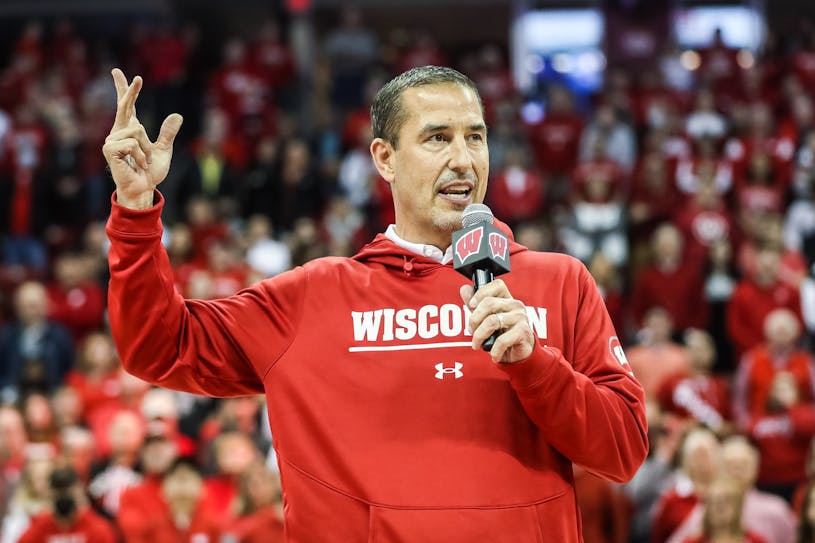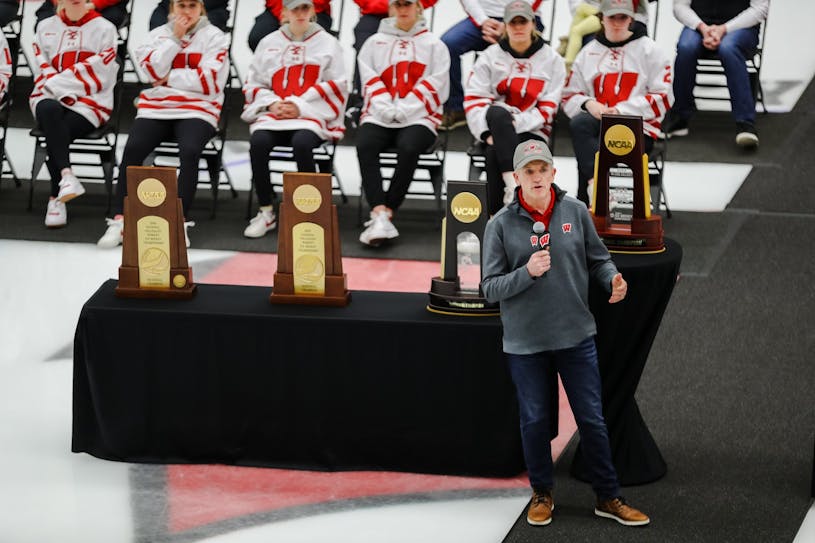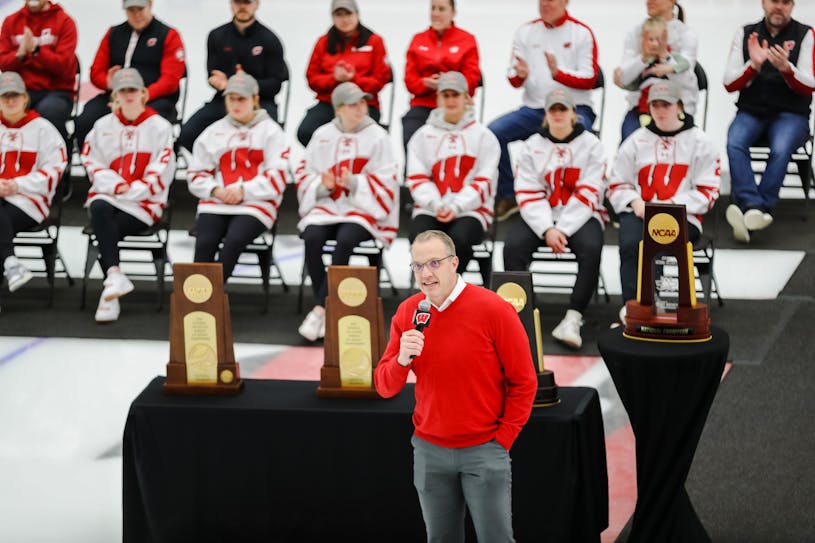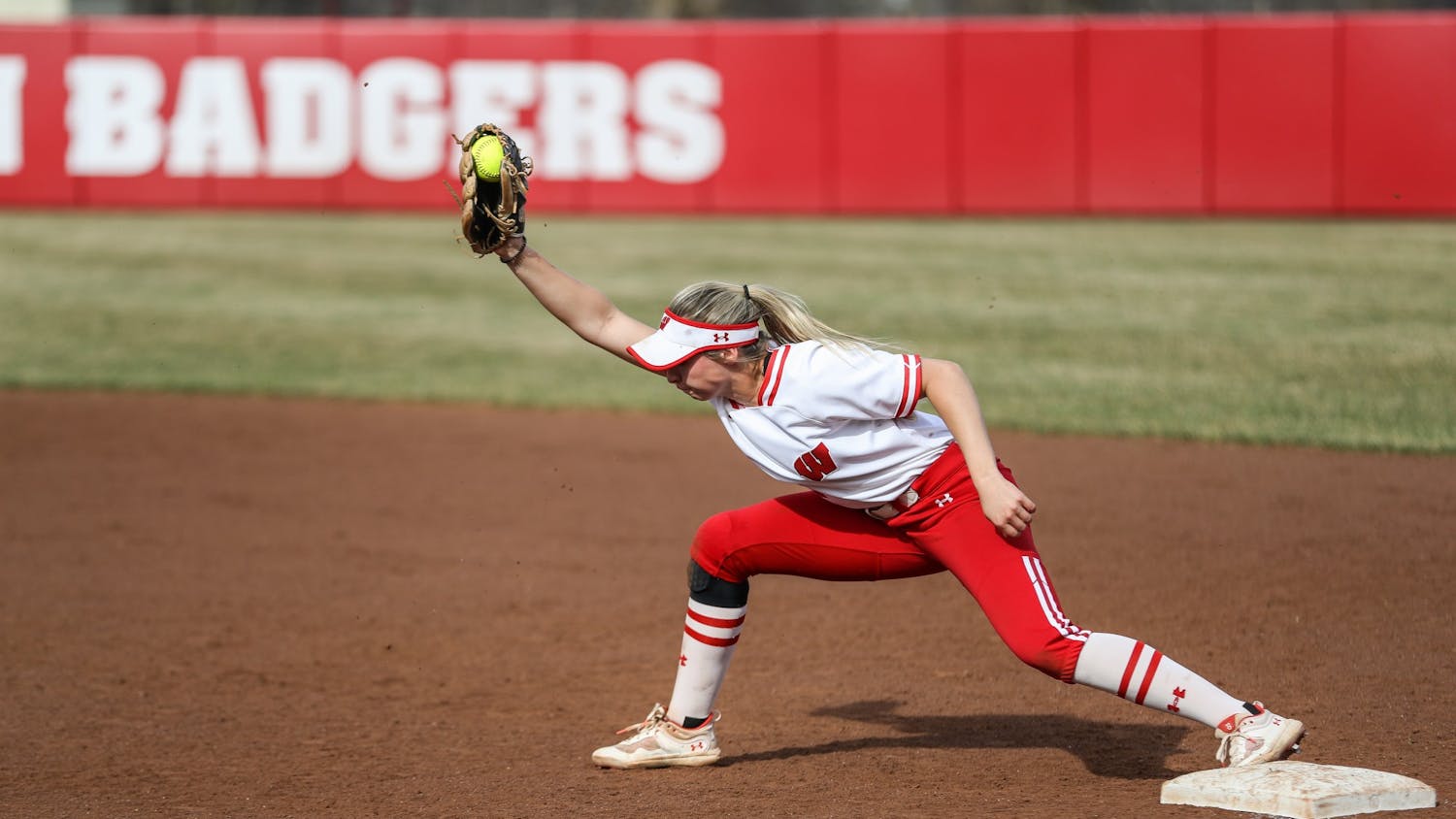It has now been nearly two full years since Chris McIntosh succeeded Barry Alvarez as athletic director.
After not making many significant decisions during the 2021-22 year, McIntosh shook the athletic program to its core in year two.
In the fall, he executed two of the boldest moves in the history of Wisconsin football — firing head football coach Paul Chryst mid-season, then hiring Luke Fickell from Cincinnati. McIntosh also later fired men’s hockey coach Tony Granato, an ex-player and two-time Big Ten Coach of the Year, after seven seasons.
While the men’s sports require overhauls, the women’s teams continue to succeed. The two most recent Wisconsin championships came from women’s sports — hockey in March and volleyball in December 2021.
Yet, despite their outstanding success, those programs are not treated with nearly the same attention or investment as the major men’s sports. They obviously don’t require the same urgent attention, but any form of attention would be a start.
Money!
McIntosh, an ex-Badger offensive lineman, has yet to shy away from investing in the football program. One of the first significant moments of his tenure was the renovation of Camp Randall’s south end zone in August 2022.
The aforementioned coach shake-up was bold enough, not to mention the $11 million it cost to get rid of Chryst and Fickell’s $7.5 million yearly salary for the next seven years.
It won’t stop there. Hiring Fickell was just the start of a major football overhaul.
“It’s no secret that we’re pursuing a new indoor practice facility,” McIntosh said during Fickell’s introductory press conference.

Almost all of these extra luxuries are possible because of boosters. Other sports aren’t privileged with a group of rich, competitive old men who can easily shell out money for a new end zone, practice facility or coach contract.
Now, it’s unrealistic to expect a volleyball coach to make as much as a football coach, but volleyball coach Kelly Sheffield deserves to at least match his peers.
Sheffield, who became the head coach in 2012, has taken the volleyball program to new heights. His teams have advanced to the Sweet 16 in all 10 of his seasons, even winning the school’s first NCAA Championship in 2021.
He is, without debate, one of the best volleyball coaches in the country. Yet, he’s compensated as if he’s just “pretty good.”
In the championship season, Sheffield earned $362,000 as a base salary, along with a bonus of $100,000 for winning the title. The coach he beat that game, Nebraska’s John Cook, recently signed an extension that will net him $675,000 yearly.
Craig Skinner, Kentucky’s coach who won the championship in 2020, made $450,000 in 2022. The most recent champion, Jerritt Elliott of Texas, earns $557,000 per year.
Sheffield’s base salary is even significantly less than that of safeties and co-defensive coordinator Colin Hitschler ($550,000), and barely higher than outside linebackers coach Matt Mitchell ($350,000). Assistant defensive coaches’ salaries match up with one of the best volleyball coaches in the country.
There are 17 total football coaches on staff, along with 19 members of the support staff — strength and conditioning, recruiting, media and more.
Volleyball, on the other hand, employs just six coaches and seven support staff members. Associate head coach Brittany Dildine made $116,349 in 2021, while Gary White, the other associate coach, earned $93,079.
Mark Johnson, the women’s hockey coach, was paid just over $380,000 in 2021, the year he won his sixth of seven championships. He’s actually paid more than a lot of his peers. Then again, he is the greatest collegiate women’s hockey coach of all time and is worth every penny and more.

Women’s hockey support is even more meager. There are only five coaches and support staffers, respectively. Associate head coach Daniel Koch, who’s been with the university since 2003, earned just over $120,000 in 2021, while assistant Jackie Crum earned $90,249.
An individual outside linebackers coach earns more than entire assistant coaching staffs on championship-winning teams.
Where the university can start
The volleyball team plays in the Field House. A beautiful, historic building that deserves an important sport like volleyball, but is not treated with the same care as the Kohl Center or Camp Randall.
When Camp Randall got an entire end zone rehauled, all the Field House got was new air conditioning and some upgraded seating.
The overhaul was announced in October 2019, 10 months after the university released the “UW Field House Historic Structure Report.” They listed several areas where the Field House needed improvement, such as masonry and roofing, yet little has been addressed.
For women’s hockey, investment is needed in the form of renovations. They play in the LaBahn Arena, which was built in 2012 and has never experienced any significant upgrades. Meanwhile, the Kohl Center will complete renovations later this year, costing over $42 million total.
If the university isn’t serious about investing in the Field House or LaBahn Arena, they can at least host more special events celebrating women’s sports.
This past volleyball season, the Badgers hosted the Florida Gators in the Kohl Center. It was the first volleyball game in the Kohl Center in 25 years and even broke the then-record for single-game college volleyball attendance at 16,833.
The women’s hockey team also appeared in the seventh-ever “Fill the Bowl” night in the Kohl Center this past season, hosting St. Cloud State and earning the second highest single-game attendance mark for a women’s hockey game at 14,430.

These events clearly garner interest. Fans care about women’s sports and want to support them. The volleyball game was a massive success — it should not have been the first Kohl Center game in 25 years. There should also be more than seven “Fill the Bowl” nights in the school’s history.
The university could easily host at least one game per year in the Kohl Center for volleyball and women’s hockey. These events should not be as rare as they are.
While this improvement is largely symbolic, it would show that the university actually cares about women’s sports and acknowledges their prominence on campus.
Regardless, major improvements will take time — whether that be paying a coach more, expanding their staff or improving buildings.
The most direct and obvious way to reward the work of women’s sports would be to improve compensation for coaches.
This isn’t just about Sheffield or Johnson. Every assistant who works alongside these teams performs to the best of their abilities, resulting in success at the highest level. Yet, they’re compensated as if they’re middling programs, like football in recent years or men’s basketball this season.
If McIntosh and company want to show aggression and care in popular men’s sports, fans should expect that attitude to carry over for women’s teams as well. Then again, they seem to be doing just fine.
Donnie Slusher is the sports editor for the Daily Cardinal. He has written multiple breaking news stories, sports columns and an in-depth examination of race in Wisconsin football. Follow Donnie on Twitter at @DonnieSlusher_






